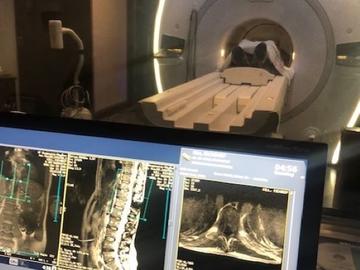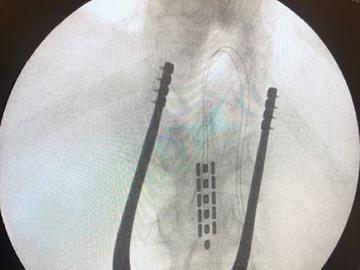Current Research

What it is
Epidural stimulation describes a process where electrical current is applied to the spinal cord. Stimulation is applied through a small implant that is placed over the dura (protective layer around the spinal cord). For people with spinal cord injury, stimulation is applied below the level of injury. The intervention is typically a 45-minute outpatient procedure (statement by Neurosurgeon Dr. Darrow, U Minnesota). To date, stimulation has resulted in a wide array of benefits. For example, we recently published work showing that stimulation allowed volitional motor function below the level of injury for people with clinically-complete injuries of more than 5-10 years. This was achieved without rehabilitation and occurred the first time we turned stimulation on. Of course, rehabilitation is likely crucial to maximize the benefits of the stimulation. We have also observed reductions in bowel time, improved sexual function, improved lower-urinary tract function, more stable blood pressure, and increased exercise capacity.
How it works
In almost all clinically-complete injuries there are some preserved connections across the site of injury, but these connections are not functional in a normal state (i.e., dormant). By applying electrical current to the nervous system circuits within the spinal cord below the level of injury, we are able to re-awaken these dormant connections. This functional re-connection allows for the brain to recover some of the lost control over systems below the level of injury. Furthermore, the spinal cord is not simply a relay pathway (i.e., highway) transmitting information from the brain to the periphery. It also contains intricate interconnections that can process information and coordinate outputs with little input from the brain. Stimulation also helps to re-awaken these complex interconnections. Together, the awakening of dormant pathways and activation of complex interconnections with stimulation often leads to meaningful improvements in function for people with spinal cord injury. We are harnessing these concepts to provide health solutions for people with spinal cord injury.
HEMO Trial
The HEMO Trial is actively recruiting participants with chronic (>12 months) spinal cord injury located between C3 and T6 who have confirmed severe orthostatic hypotension and autonomic dysreflexia. The purpose of this study is to stimulate the circuits in the spinal cord that are directly responsible for hemodynamic control to restore hemodynamic stability. The ultimate objective of this study is to provide preliminary safety and efficacy measures on the ability of the hemodynamic Targeted Epidural Spinal Stimulation (TESS) to ensure the long-term management of hemodynamic instability and reduce the incidence and severity of orthostatic hypotension and autonomic dysreflexia episodes in individuals with chronic cervical or high-thoracic spinal cord injury. In addition, the long-term safety and efficacy of TESS on cardiovascular health, respiratory function, and quality of life in participants with chronic spinal cord injury will be evaluated.
Download the SpineAlly app today!
SpineAlly is a ground-breaking mobile application designed to empower individuals with spinal cord injuries by providing them with a comprehensive toolset for monitoring, tracking, and enhancing their overall health and well-being. This user-friendly app is built to help those with spinal cord injuries in their daily lives, offering essential resources, symptom tracking, and educational content.

Knowledge Assessment of Health After Spinal Cord Injury
The study
Mobility is a well-researched priority for individuals with spinal cord injury (SCI). However, most people with SCI experience other, 'secondary' health concerns in addition to mobility impairments. Knowledge of these secondary health outcomes have not been well evaluated in Canadians living with SCI.
The primary purpose of this study is to evaluate knowledge levels of secondary health outcomes in individuals with SCI. This will be done through an online survey. This survey should take approximately 20 minutes to complete.
Individuals who take part in the online survey, and who live in the Calgary area, will be invited to take part in a second portion of the study. The purpose of this part of the study is to compare self-reported symptoms of secondary health outcomes with results from physiological assessments of these secondary health outcomes. This will be done during 3 in-person study visits at the University of Calgary.
Interested in participating?
Are you a person, age 18+, living with Spinal Cord Injury? We need your help! The research team of Dr. Aaron Phillips, Assistant Professor at the University of Calgary, and the RESTORE Network is conducting a research study titled: “Knowledge Assessment of Secondary Health Outcomes Post Spinal Cord Injury.” We are in search of volunteers to fill out a survey related to health after Spinal Cord Injury. Please click on the link below to access the survey via the secure Qualtrics platform. This study has been approved by the University of Calgary Conjoint Health Research Ethics Board (REB21-0045).





